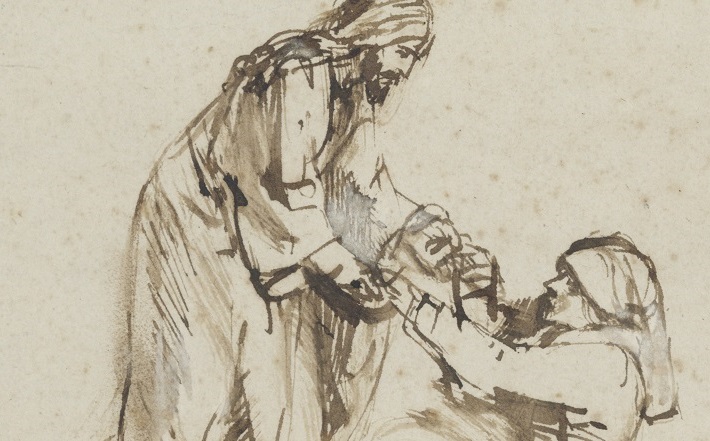Commentary on Mark 1:29-39
If the vibe of last week’s Capernaum synagogue narrative was public and confrontational, this week’s pericope picks up the same apocalyptic story with a decidedly private, even mystical feel. Mark 1:29–39 brings us into home, hearth, prayer, and purpose to experience Jesus’ gospel of God from the inside out.
The sacred time is still the same. This more private narrative in 1:29–39 still presupposes the Sabbath observance and all its meanings from 1:21–28. At this point, however, Jesus and his four disciples leave the synagogue and enter a nearby house, the home of Simon and Andrew.
It is telling that the need for Jesus’ ministry is found in private spaces, too. Simon’s mother-in-law, who lived in the home, had come down with a fever. Andrew and Simon were keen to update Jesus on her situation when they entered.
Apocalyptic at home
By now, those of us familiar with Jesus narratives expect that a healing is at hand. What is remarkable about this healing, however, is its brevity and its tenderness. In verse 31 Jesus “came and took her by the hand and lifted her up.” The action is simple and direct and not as elaborate as some other healing stories. Here the embodied action speaks volumes.
Scholars like Joel Marcus note the resonance of Jesus taking the hand of a person he was healing and its link to “lifting her up” themselves as acts reminiscent of resurrection (for example, the delayed approach to the young girl in Mark 5:21–43).1
With a similar economy of language, Simon’s mother-in-law is restored and begins to serve them. Please note that Mark’s use of the verb “serve” in this context is the same one used to describe the angels’ service to Jesus in the wilderness back in 1:12. We may be in a home, but the horizon of service is still the divine purpose and not just another reinscribing of traditional gender roles.
Apocalyptic on the front porch as night falls
Mark is careful to mention time changes more than once in 1:29–39. And we should expect it as readers since all of this continues to be related to Sabbath practice. With the arrival of evening at sunset, the Sabbath is concluded. And now, like some seed sprouting vigorously in the dark, it seems the whole town is joining in the emerging healing and restoration. Still at Simon and Andrew’s home, Jesus has brought to him all the town’s sick and possessed people. Mark, as narrator, wants to help readers draw the right conclusions with his phrase “and the whole city was gathered around the door.”
People are beginning to throng Jesus, and it all begins at the home of Simon and Andrew just as the Sabbath ends. Jesus obliges by healing many and casting out even more demons. Yet he still desires to keep his identity under wraps and so, as in 1:21–28, makes sure to keep the demons from disclosing anything. The reader is invited to be in the know here with a demonic clausal reference easily passed over: “because they knew him.” Mark is not the most artful narrator, but the way he tells the story brings out in passing that this Jesus is something more.
And all this is important. Not because the events happen in an important place or to important people, but because Jesus’ own epiphany is both hidden and revealed. The demons were silenced because they knew his significance. And they were silenced, and the secret kept, at the door of a home with a mother-in-law in a city where the sick and the possessed just kept showing up. Such is the coming reign at the end of Jesus’ Sabbath in Capernaum. And here the very gospel of God has come to a home and to persons at the sunset of the day at a city in Galilee.
A mystical turn to prayer: Jesus hidden and revealed
Most scholars interpret the material toward the end of this pericope as “summary” sections. I do not deny the truth of that. Mark likes to offer summaries at various points in the Gospel, usually as a way of identifying where the action shifts, but also to highlight the general acclaim and response that Jesus is receiving. That’s all true.
Even so, I want to stick to the micro-narrative level here. My sense is that Mark wants to highlight just one more thing about the epiphany of this Jesus healer/exorcist who aims to be both hidden and revealed in a home in Capernaum. The narrative points out that the next thing Jesus does is to steal away and pray. Mark is even careful to note the time of day: “In the morning, while it was still very dark, he got up and went to a deserted place, and there he prayed.”
Who does this? I do pray, but I am certainly no rise-and-shine mystic. I live in the noontime brightness on the other side of disenchantment, which is just a few miles north of Boston. Yet Mark has been careful to portray Jesus as something special: a charismatic, apocalyptic healer whose hand and touch matter for the well-being of others. Yet this same Jesus prays, like many a mystic, to be grounded in God. The disciples and all the others are more perturbed than understanding about his departure to pray alone. Mark even says that in their desperation to find Jesus they “hunted him down” (katediõxen).
But they did not really need to find him. Instead, fresh out of his time of prayer, he announces something of his purpose to proclaim. And only here can any ensuing summary make sense. This Jesus, grounded in his deep relation to God, announces that it is time to go through all of Galilee to preach, exorcise, and heal. But the summary is not the point. The point is God … and Jesus prayerfully rooted within.
The inside-out apocalyptic gospel of 1:29–39
That’s why I call this pericope “the gospel from the inside out.” Jesus is beginning his ministry at Capernaum in Galilee. And he starts with a public confrontation with apocalyptic forces in the middle of a synagogue. And yet, it does more. It goes also to the home, to the hearth, and to prayer, while moving ever toward an apocalyptic purpose grounded in the very Godness of God.
Notes
- Joel Marcus, Mark 1–8, Anchor Bible 27 (New Haven: Yale University Press, 2000), 199.


February 4, 2024